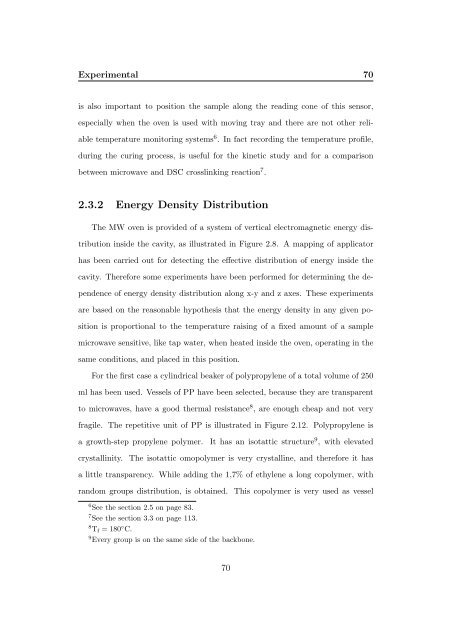Kinetic Analysis and Characterization of Epoxy Resins ... - FedOA
Kinetic Analysis and Characterization of Epoxy Resins ... - FedOA
Kinetic Analysis and Characterization of Epoxy Resins ... - FedOA
You also want an ePaper? Increase the reach of your titles
YUMPU automatically turns print PDFs into web optimized ePapers that Google loves.
Experimental 70<br />
is also important to position the sample along the reading cone <strong>of</strong> this sensor,<br />
especially when the oven is used with moving tray <strong>and</strong> there are not other reliable<br />
temperature monitoring systems 6 . In fact recording the temperature pr<strong>of</strong>ile,<br />
during the curing process, is useful for the kinetic study <strong>and</strong> for a comparison<br />
between microwave <strong>and</strong> DSC crosslinking reaction 7 .<br />
2.3.2 Energy Density Distribution<br />
The MW oven is provided <strong>of</strong> a system <strong>of</strong> vertical electromagnetic energy distribution<br />
inside the cavity, as illustrated in Figure 2.8. A mapping <strong>of</strong> applicator<br />
has been carried out for detecting the effective distribution <strong>of</strong> energy inside the<br />
cavity. Therefore some experiments have been performed for determining the dependence<br />
<strong>of</strong> energy density distribution along x-y <strong>and</strong> z axes. These experiments<br />
are based on the reasonable hypothesis that the energy density in any given position<br />
is proportional to the temperature raising <strong>of</strong> a fixed amount <strong>of</strong> a sample<br />
microwave sensitive, like tap water, when heated inside the oven, operating in the<br />
same conditions, <strong>and</strong> placed in this position.<br />
For the first case a cylindrical beaker <strong>of</strong> polypropylene <strong>of</strong> a total volume <strong>of</strong> 250<br />
ml has been used. Vessels <strong>of</strong> PP have been selected, because they are transparent<br />
to microwaves, have a good thermal resistance 8 , are enough cheap <strong>and</strong> not very<br />
fragile. The repetitive unit <strong>of</strong> PP is illustrated in Figure 2.12. Polypropylene is<br />
a growth-step propylene polymer.<br />
It has an isotattic structure 9 , with elevated<br />
crystallinity. The isotattic omopolymer is very crystalline, <strong>and</strong> therefore it has<br />
a little transparency. While adding the 1,7% <strong>of</strong> ethylene a long copolymer, with<br />
r<strong>and</strong>om groups distribution, is obtained. This copolymer is very used as vessel<br />
6 See the section 2.5 on page 83.<br />
7 See the section 3.3 on page 113.<br />
8 T f = 180 ◦ C.<br />
9 Every group is on the same side <strong>of</strong> the backbone.<br />
70
















